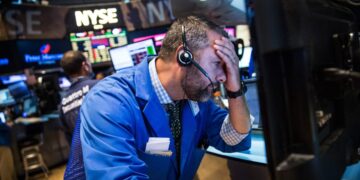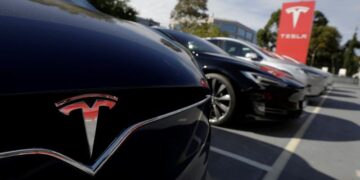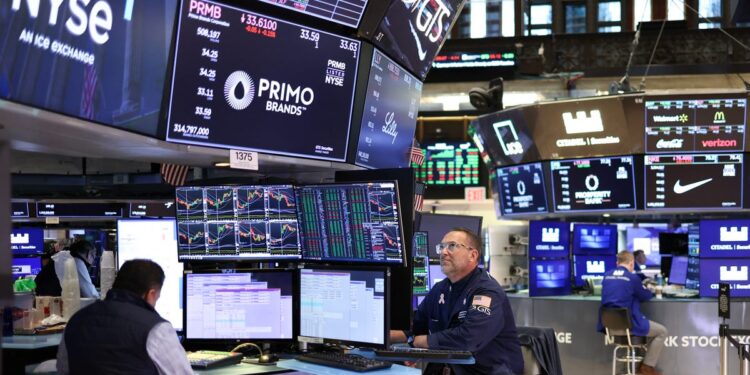The trade war hits stock markets — how can you protect your finances?
The global trade war has hit the stock markets — this is how you can protect your finances.
U.S. stocks ended lower, with the blue-chip Dow tumbling about 970 points and on pace for its worst April since 1932, amid fears President Donald Trump’s tariff plan and his attack on Federal Reserve Chairman Jerome Powell will hurt the economy.
The Dow lost 2.48%, or 971.82 points, to 38,170.41; the broad S&P 500 slumped 2.36%, or 124.50 points, to 5,158.20; and the tech-laden Nasdaq shed 2.55%, or 415.55 points, to 15,870.90. The benchmark 10-year yield rose to 4.413%.
The day’s losses added to last week’s decline. Stocks ended last week in the red, making it the third out of four losing weeks for the S&P 500 and Nasdaq.
On Sunday, Chicago Federal Reserve President Austan Goolsbee said in a CBS interview that the tariffs could lead U.S. economic activity to “fall off” by the summer from “artificially high” activity caused by panic purchasing ahead of tariffs.
Last week, Fed Chair Jerome Powell said Trump’s tariffs could present a potential conflict between its mandates to keep prices stable and promote full employment. He said the Fed could wait for more clarity on tariffs and their effect on the economy.
Anxiety about tariffs is high among business leaders, too. Executives from Walmart, Home Depot, Lowe’s and Target are meeting with Trump to discuss relief from sweeping tariffs, media reports said.
Meanwhile, Trump is also escalating his attacks on Powell, which has people nervous about the Fed’s independence to decide monetary policy. Monday morning, Trump again demanded in a social media post that “loser” Powell lower rates “NOW”.
“If the independence of the Federal Reserve were to come into question, and especially if that concern were to materialize, it could further erode foreign investor confidence in U.S. dollar-denominated assets,” said Mike Goosay, Principal Asset Management’s chief investment officer and global head of fixed income.
On Friday, White House economic adviser Kevin Hassett said that Trump and his team would study whether firing the Fed Chair was an option.
That followed Trump’s comments on Thursday that Powell’s “termination cannot come fast enough,” as the President renewed his calls for more interest-rate cuts.
This isn’t the first time Trump has hounded Powell to lower rates. He did so in 2018 during his first presidency. Some felt Trump was successful because Powell eventually cut rates.
Can Trump fire Powell?
Some analysts and economists are closely watching a Supreme Court case involving Trump’s firing of Democrats from two federal labor boards as to what type of power Trump has over independent agencies, including the Fed.
The Supreme Court last week cleared the way for Trump to remove the two employees for now. The stay gives the Supreme Court time to consider the Trump administration’s formal request to block lower courts’ orders to reinstate them while litigation over the firings continues.
How could markets react to a new Fed chair?
How markets would react to a new Fed chair would depend on who it is, said Paul Ashworth, chief North America economist at Capital Economics.
“If President Donald Trump does fire Fed Chair Jerome Powell, we suspect that the initial market reaction might not be disastrous, as long as Trump quickly lines up a relatively qualified replacement, like Kevin Hassett or Kevin Warsh,” Ashworth said.
However, if lower rates is what Trump’s aim is, “firing Powell would just be the first step in dismantling the Fed’s independence. If Trump is set on lowering interest rates, then he will have to fire the other six Fed Board Members too, which would trigger a more severe market backlash,” Ashworth said.
Companies’ silence speaks volumes about outlook
Though quarterly results have so far been pretty strong, Bank of America analysts note that businesses are shying away from offering forward looking guidance. Companies tend to shut down guidance amid uncertainty, it said. During the pandemic, just 10% of companies issued annual guidance compared to an average of 40% in the four quarters prior, it said.
“There’s no doubt that tariffs are already creating a sense of uncertainty,” Goosay said. “That uncertainty is weighing on market sentiment and growth prospects.”
So far this month, only eight S&P companies have issued earnings guidance, and none guided above-consensus analyst estimates, Bank of America said. Three-month forward guidance is tracking the weakest since the pandemic.
On earnings calls, “mentions of “better” or “stronger” versus “worse” or “weaker” have dropped much more substantially to below average, and while early, are so far tracking the weakest since 2009,” it said.
Globally, signs of tariffs emerge, too
Around the globe, signs of Trump’s tariff war can be seen, too. DHL is suspending high-value shipments to the U.S., effective Monday, as it struggles with delays from customs clearances amid the new U.S. rules, and China warned countries not to do trade deals with the U.S. that isolate China, the WSJ said.
And as South Korea heads to Washington this week for tariff talks, the country’s customs office said exports fell 5.2% from a year earlier in the first 20 days of April and imports dropped 12%, leading to a trade deficit.
Dollar plunges as markets tumble
The U.S. dollar hit a three-year low as confidence falls in the U.S. economy and in the greenback as the world’s safe reserve currency.
Trump’s tariff plan “has resulted in a sharp fall in the dollar and what looks increasingly like a generalized loss of confidence in the U.S. as a safe haven in currency and bond markets,” Jonas Goltermann, deputy chief markets economist at Capital Economics said in a note last week.
Paul Singer, founder of Elliott Investment Management, warned recently at a private event in Abu Dhabi that the U.S. dollar might lose its reserve currency status, according to Bloomberg, citing people present.
Gold soars to new record
Gold climbed to a record high above $3,400 per ounce amid the uncertainty. Gold is seen as a safe asset during tumultuous times.
“The rally remains supported by three core drivers: growing expectations that the Federal Reserve will soon shift to monetary easing, escalating trade tensions between the U.S. and China, and persistent geopolitical risks—especially as peace efforts between Russia and Ukraine remain stalled,” said Linh Tran, market analyst at broker XS.com.
Company news
- Tesla has delayed the launch of its cheaper Model Y car, according to Reuters. The EV-maker’s quarterly earnings are due Tuesday. Tesla shares fell almost 6%.
- Uber shares slumped 3% after the Federal Trade Commission sued the ride-share company for billing and cancellation practices related to its Uber One subscription service.
- Nvidia shares dropped 4.5% after Reuters reported competitor Huawei Technologies planned to begin mass shipments of an advanced AI chip to Chinese customers as early as next month.
- Capital One Financial received approval from U.S. banking regulators on Friday for its $35.3 billion purchase of Discover Financial Services. Capital One stock gained 1.5% and Discover rose 3.5%
Cryptocurrency
Bitcoin rose to its highest level since March after convincingly breaking above the key $85,000 level. The digital coin was last up 2,57% at $87,347.84.
Bitcoin’s fortunes pulled up stocks like Strategy, formerly MicroStrategy, which invests heavily in the digital asset. But by the afternoon, shares were struggling along with the broader stock market. Shares of Strategy were up fractionally.
This story was updated with new information.
Medora Lee is a money, markets, and personal finance reporter at USA TODAY. You can reach her at mjlee@usatoday.com and subscribe to our free Daily Money newsletter for personal finance tips and business news every Monday through Friday.














